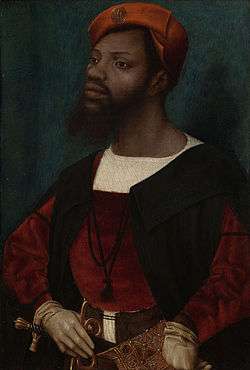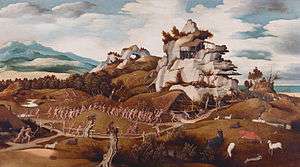Jan Mostaert
| Jan Jansz Mostaert | |
|---|---|
|
Jan Mostaert, Landscape with an Episode from the Conquest of America, better known as the West Indies Landscape | |
| Born |
c. 1475 Haarlem |
| Died |
1555/1556 Antwerp |
| Nationality | Netherlandish |
| Known for | Painting |
Jan Mostaert, also known by the names Joannes Sinapius and Master Of Oultremont (c. 1475 – 1555/1556) was a Netherlandish Renaissance painter of portraits and religious subjects, though his most famous creation was the West Indies Landscape.
Biography

According to Karel van Mander, Mostaert was born in Haarlem and had been a pupil of Jacob van Haarlem, the painter that painted the altarpiece of the Carrier's guild there in the St. Bavochurch.[1] He was handsome, eloquent and polite, and claimed to be descended from the Haarlem knights of the Crusade to Damietta.[1] He worked eighteen years as portraitist for Margaret of Austria (1480-1530), governor of the Habsburg Netherlands.[1] He died in Antwerp where he had been awarded a pension for life.[1] Mostaert's name first appeared in city records in 1498, the year he married and bought a house in his birthplace. He is also mentioned in Haarlem archives from 1527 to 1554. In 1500 Mostaert was commissioned to paint the shutters for a receptacle housing the relics of Saint Bavo in the Groote Kerk, Haarlem. From this date he began to be listed in the records of the Haarlem Guild of St. Luke, and continued to be frequently listed until 1549. He became deacon of the painters' guild in 1507, and again in 1543 and 1544.
According to the Netherlands Institute for Art History (RKD) he worked for the Regentess from 1503–1521, returned to Haarlem, and moved to Antwerp around 1552.[2]
Works

Mostaert's teacher Jacob van Haarlem may have actually been the anonymous Master of the Brunswick Diptych. Karel van Mander described several works in detail, including his strange landscape of the West Indies, which he considered to be an unfinished work. Much of Mostaert's work was destroyed in the great fire of Haarlem in 1576, and some paintings once attributed to him are now attributed to Adriaen Isenbrant.
His earliest works are noticeably influenced by Geertgen tot Sint Jans, an earlier Haarlem artist. Some believed that Mostaert was actually apprenticed to Geertgen but it is doubtful that the artist had any apprentices or workshop assistants during his career. From Geertgen, Mostaert adopted a refined style and thoughtful compositions for his works, as well as the stiff, angular look of his figures.
Between 1510 and 1516 Mostaert developed a delicate style where his doll-like figures inhabited bright, blue-skied landscapes, as for example in his Adoration of the Magi (c. 1520–25). His refined brushwork is precise, with an almost religious attention to detail. Also of note is the landscape, which demonstrates his leanings towards more romantic views with expansive hills. During the 1520s Mostaert was also influenced by Joachim Patinir's take on landscapes. Mostaert's St. Christopher, a painting with a landscape that features a river receding into an expansive and hilly background, was once even attributed to Patinir.
Mostaert's portrait work of this earlier period includes a piece entitled Portrait of Abel van den Coulster (c. 1500–10), in which an elegant, thin-faced man is situated in equally elegant surroundings. Mostaert was known for copying original portraits for some of his courtly commissions but, as is the case with the Portrait of Abel, he also painted figures from life and added aristocratic touches. He was known for presenting his portrait sitters in three-quarter-length and placing their hands on cushions.
Being an accomplished court painter allowed for Mostaert to make a living off his art and to gain a steady patronage. The last documented reference to him is in 1549 when he petitioned the Haarlem town council for permission to live in Hoorn so that he could complete an altarpiece there.
Margaret of Austria
In 1518, Margaret named Mostaert "peintre d'honneur." Under her employ, he was commissioned to create portraits, though he also produced a number of devotional images as well as portraits for the lesser Dutch nobility.[3]
As was common practice in 15th and 16th century Netherlands, Mostaert frequently reproduced portraits of political figures based on original models. In 1521, Mostaert gave Margaret a portrait of her third husband, Duke Philibert of Savoy, as a New Year's present. The portrait was made sixteen years after Duke Philibert's death.
Portrait of an African Man

Mostaert accompanied Margaret on many of her travels and painted many portraits of her courtiers, coming into contact with upper class and public figures. One such figure is presented in Portrait of an African Man (c. 1525–30, Rijksmuseum[4]). It is not known exactly who this man was but there are indications that he was either associated with Margaret's court or was an attendant of her nephew, Charles V, who had a black archer, Christophle le More, among his bodyguards.[4] The man wears rich clothes, gloves, and holds a sword, all indicative of his important status. The insignia on his hat and bag allude to possible Spanish or Portuguese origins. Many of the Africans who arrived in Europe in late medieval and early Renaissance times were scholars and advisers.[5]
Mostaert also painted a diptych for Margaret, the iconography of which may have been based on mystic literature of the Spanish court, with which Margaret had close connections.
West Indies Landscape
Mostaert's most famous work is the West Indies Landscape (c. 1535, Rijksmuseum[6]), which is believed to be a view of the Zuni pueblos in New Mexico. Having never travelled to the Americas, Mostaert had to imagine what the New World looked like. There was speculation that the artist may have seen sketches of the landscapes but this is unlikely since most pictorial documentation of the times was of exotic animals, tools or costumes, rather than panoramic views. Also, the fanciful cliffs seem to be influenced by Patinir's landscape style rather than authentic renderings. It is believed that Mostaert created the painting based on either written or oral accounts of the newly discovered area to which he would have been privy thanks to his contacts at the court of Margaret of Austria, the aunt of Charles V.
Although the narrative in the painting was thought to depict a number of different events, including Columbus on the island of Guanaja, Hernán Cortés in Mexico, and the Portuguese invasion of Brazil, it is actually the story of Coronado's search for the seven cities of gold in the Zuni village of Cibola in New Mexico and Arizona in 1540–42.
The best evidence that the picture is based on Coronado's story can be found at the right side of the painting, by the base of the cliffs. On his travels, Coronado was stoned at the entrance to the village by the native Indians. He was rescued by two of his officers who came to his aid and warded off the incoming Indians. Mostaert may have added the event to the landscape to lend it a measure of credibility.
The landscape's terrain, as well as the look of the natives, also matches the descriptions of Pedro de Castañeda, a member of Coronado's team, made during his travels. According to him, the land was full of cliffs, some with ladders on them reaching to different levels, the people were tall and naked, and their huts were built into the ground and made of straw, the roofs protruding from the ground.
Mostaert devotes only a small section of the painting to Coronado and his men, showing us instead the unity and strength of the native peoples fighting for their land. The painting is one of the earliest depictions of the Europeans' invasions of the Americas and of the "noble savage."
Themes
One of Mostaert's favorite themes was the Vision of Augustus and the Tiburtine Sibyl. An abbreviated version can be seen in the top half of his Adoration of the Magi. It can also be found in the broad courtyard in the background of his Portrait of Abel van den Coulster.
Recent controversy

Mostaert's Portrait of a Courtier, a painting that until 2005 had been in the collection of the Virginia Museum of Fine Arts since 1949, was found to have been confiscated by Nazi forces in 1941 from its rightful owners in Poland. It had come from a collection of artworks amassed by princess Izabela Fleming née Czartoryska. The paintings were moved to Warsaw as war loomed but were inevitably seized by the Germans.
The VMFA made the decision to deaccession and transfer the work to the Polish Embassy, acting on behalf of the rightful owners' family. The family donated the painting to the Czartoryski Museum in Kraków, Poland.
The small, oil-on-panel portrait is known to have had at least three different titles: Duke of Burgundy, Portrait of Charles VIII, and Portrait of a Courtier. It was once paired with a portrait of a lady, thought to be Anne of Brittany, the wife of Charles VIII, King of France.
Legacy
Although a renaissance painter of portraits and devotional imagery, Mostaert also had a fascination with primitive peoples and lands, as seen in his West Indies Landscape. At around 1520–25 he presented the family life of Adam and Eve in First Family as primitives working on their land. Mostaert was interested in combining pagan and Christian interpretations of humanity's origins. His son was a common painter and was not named by Karel van Mander, but his twin grandsons Frans and Gillis both became respected landscape painters.
References
- 1 2 3 4 (Dutch) Jan Mostaert in Karel van Mander's Schilder-boeck, 1604, courtesy of the Digital library for Dutch literature
- ↑ "Jan Mostaert". RKD. Retrieved 2016-09-22.
- ↑ This is the accepted account by Karel van Mander, who wrote that Mostaert was a portrait painter for the court of Margaret of Austria for 18 years. It is not likely however that Mostaert worked for her for that long a period. He is missing from archival records for a string of only 10 years, and only two documents from 1519 and 1521 give any mention that he was working at her court at the time. Cf. The Jack and Belle Linsky Collection in the Metropolitan Museum of Art/E0950P. Metropolitan Museum of Art. 1984. p. 77.
- 1 2 "Portrait of an African Man". Rijksstudio. Amsterdam: Rijksmuseum. Retrieved 2016-09-22.
- ↑ Jablonski, Nina (2012). Living Color. Berkeley, Los Angeles, London: University of California Press. ISBN 978-0-520-25153-3.
- ↑ "Landscape with an Episode from the Conquest of America". Rijksstudio. Amsterdam: Rijksmuseum. Retrieved 2016-09-22.
- ↑ "Jan Mostaert – Portrait of a Courtier". Archive.is. Retrieved 2014-05-11.
- Snyder, James, 2005 (2nd edn). Northern Renaissance Art. Pearson Education. ISBN 0-13-189564-8
External links
| Wikimedia Commons has media related to Jan Mostaert. |
